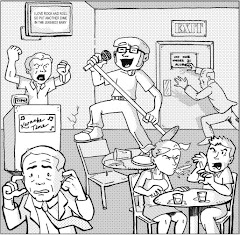
Girls #10, February 2006, Image Comics
by Joshua and Jonathan Luna
This St. Patrick’s Day, men across the country, perhaps even around the world, will take to the streets in search of forbidden treasure. No, I’m not talking about a leprechaun’s pot of gold at the end of the rainbow . . . I’m talking about the affections of a woman. Sure, chugging green beer has become a holiday tradition (though the practice really offers no real insight into Irish culture), but some three or four beers into the evening, St. Patrick’s Day becomes just another night at the bar, and therefore just another attempt to score a woman’s phone number, or more. Is this why St. Patrick’s Day lands within Women’s History Month? To remind us that, even on a day where heavy drinking is encouraged and celebrated, women are more than potential treasures to be scored and spent?
The torrid universal relationship between men and women has become a perpetual subplot in all of comicdom, and no one comic book has gone to such great lengths to draw the line in the sand as much as the Luna Brothers’ Girls. I mentioned yesterday that I’d read Girls #1 before, in the Image First compilation, and I really enjoyed the Lunas’ use of candor and raw (albeit drunken -- sigh, those libations will be the death of us men) emotion to establish conflict and the cast of characters in their rural setting of Pennystown. Nine issues later, the plights of these diverse personalities have taken a distinctly different turn; whereas before these townsfolk merely sought to pass away their idle lives in Midwestern bliss, they now strive simply to survive . . . against an odd army of freshly hatched, naked, flesh-eating women. Yes, you read that right.
In this issue, a majority of Pennystown’s (which isn’t really a lot) have congregated and sheltered themselves in a secluded mansion. Unfortunately, the youngest children have recklessly wandered outside into the surrounding forest, and a brave group decides to search of them. The kids are found but only when a gang of the naked women emerge from the wood, and the survivors rush back to the mansion with those flesh-hungry chicks practically nipping at their heels. In the house, the power goes out, and the folks inside scramble to gather a flashlight and some weapons as they hear their friends hastily return. The Luna Brothers’ ability to infuse this climactic scene with a palpable sense of suspense is brilliant and impressive, as the second to last page is simply a series of black panels and frightened dialogue, proving that a horror comic can really accomplish a lot with a little.
Of course, this issue’s fright factor is laced with relationship-ridden subplots, but trying to summarize them here wouldn’t do them justice. It’s enough that these core characters are pursued by freshly hatched, naked, flesh-eating women, right?
Needless to say, although I don’t know the ultimate outcome of this series, I can safely assume that the Lunas managed to spin the zombie genre on its ear with Girls. Rather than terrorize their simple townsfolk with decrepit undead, they unleashed a band of beautiful women, and while these ladies are obviously much easier to look at, they aren’t any less ruthless in their methods or madness. Women often claim that men are shallow in their attraction to pure physicality, but what if this physicality could be harnessed as a weapon? What if those moments of paralysis at the sight of beautiful and surprisingly naked woman were all those women needed to feast and survive? Wouldn’t our superficiality become a valuable asset? Of course, I know plenty of chicks that really do use their looks to score a free meal, just not one of flesh, so maybe the Lunas weren’t too far off with this potentially allegorical tale of gender-based horror and romance.
Indeed, from the recent ethereal dissolution of Spider-man’s marriage in One More Day to the likes of introspective independent artists like Jeffery Brown, such romantic inclinations are often the most grounding elements throughout any genre of comicdom. While the average fanboy cannot train his mind and body to the pinnacle of human perfection like Batman, they can at least relate to his inability to commit to any one woman . . . or maybe envy it. Similarly, older readers can appreciate the complexities more stable relationships like the Storms’ or Wally and Linda Wests’ offer. From fawning over Lana in Smallville to the classic love triangle from Superman tales of old, readers could revel that even the Man of Steel gets butterflies in his stomach around the special little lady. Hey, maybe you’ve never been pursued by freshly hatched, naked, flesh-eating women, but you’ve broken up with a girlfriend before, right? You’ve thought you were flirting with a girl only to learn that her intentions were strictly platonic? In this context, what does a series like Girls teach us?
Men, beware. They can be more than they appear to be. You’re better off looking for that leprechaun. That little guy’s almost more believable than the concept of the perfect woman . . . at least when you’re looking through the bottom of a bottle.



